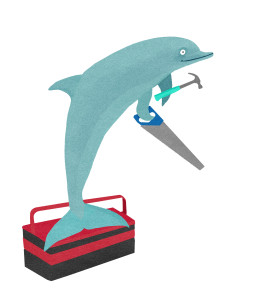Animal Counting Toolkit
Knowing how many animals are in an area, and how they are distributed, is a central task in conservation science. This information is used to assess whether fisheries are catching more marine mammals in their fishing nets than the population can withstand, to guide spatial plans for protecting critical habitat, or assessing risk of human activities, such as windfarm construction or shipping lanes. The problem is that ship time is expensive. We partnered with Dr Randall Reeves (Okapi Wildlife Associates and IUCN Cetacean Specialist Group) and Dr Jeff Moore (NOAA Fisheries’ Southwest Science Center) to build a toolkit for low-cost, small-boat surveys as a way to estimate marine mammal abundance in coastal regions where funding is scarce. Our primary focus is on places where fisheries bycatch is thought to be high, but the toolkit can be used also to collect data to help guide marine spatial planning, measuring marine biodiversity, or assessing trends in marine predator populations.
Science is self-correcting. Scientific knowledge improves over time. We get this, of course. Every now and then we look back at some of our published studies and realize we could have done things better, faster, or more efficiently than we did the first time.
That’s where our Animal Counting Toolkit comes in
With partners from IUCN, NOAA, CyberTracker, University of St Andrews, BlueWater GIS, and others, we have compiled a simple, how-to guide to design and conduct a small-boat survey to estimate abundance and distribution of marine wildlife. The Animal Counting Toolkit approach is not a new method. Instead, it synthesizes lessons we’ve learned over the last 15 years or so in adapting scientific best practices to work on a small budget. It provides a gentle introduction to previously disparate advice on survey design, field methods, and analysis of line transect survey data.
We want to be clear about our toolkit’s intended audience. We are sharing information from the perspective of conservation practitioners with practical field experience. The statisticians at the University of St Andrews are the world’s experts in the theory of line transect methods to estimate animal abundance. Please take their online course if you’re interested in the theory, statistical analysis, or software. Join their list if you are interested in staying up to date on analysis. Our toolkit is designed to share lessons learned in using distance sampling methods in the field.
Ready to use our Animal Counting Toolkit?
- We’ve launched the toolkit with a paper in Endangered Species Research. Please start by downloading and reading the paper.
- Be sure to download the Supplementary Material as well. This material contains all of our projects, templates, and raw data from our first case study off northern Vancouver Island, including a Distance project for survey design, a CyberTracker template for data collection, the raw data, and the Distance project for analysis.
- Refer to this useful Checklist for the software and other suggested items you will need for your Toolkit.
- We’ve also produced a series of Videos which we encourage you to view before you get started. These videos will explain the methods without using (much) jargon.
- Video 1 — Small Boat Toolkit Introduction
- Video 2 — Defining a Survey Region
- Video 3 — Designing a Survey
- Video 4 — Field Protocols
Next steps for the Animal Counting Toolkit
As we scale up this program, we intend to share lessons learned from an application of the toolkit in Indonesia with our colleague, Dr Putu Liza (Icha) Mustika. We are looking for potential partnerships, so please let us know if you think this toolkit and a training program could be useful in your study site. Let us know if you’d like the raw video files, so you can translate the advice to languages other than English. Our intent is to have this page become a discussion board for practitioners to share lessons, successes, and failures with colleagues.

